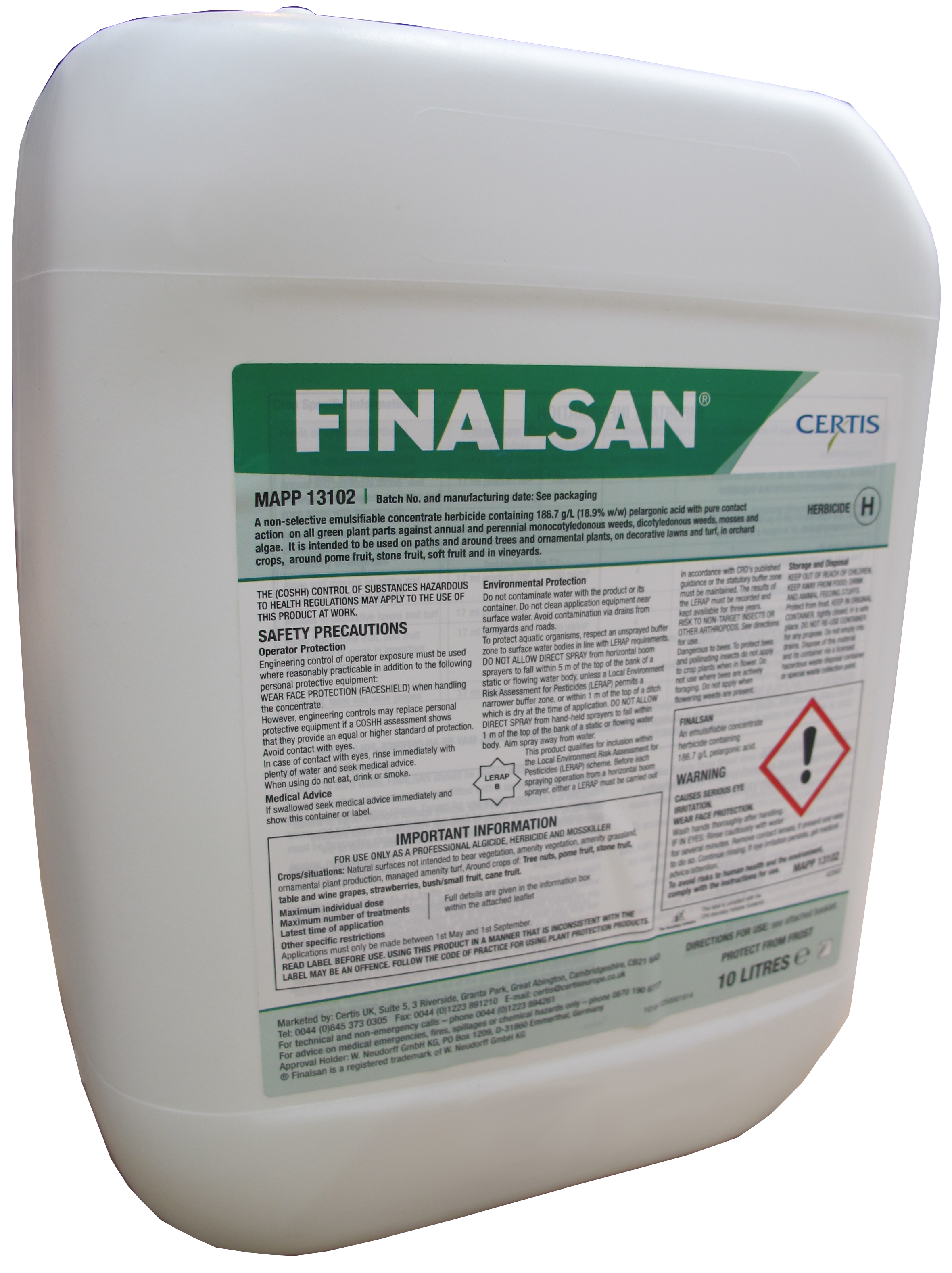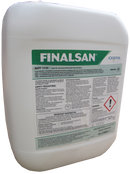Description
Finalsan Herbicide
| Product Overview | |
|---|---|
| Product Type | Herbicide |
| Product Name | Finalsan® |
| MAPP No. | 13102 |
| Active Substances | Fatty acids: pelargonic acid |
| Formulation | Emulsifiable concentrate |
| Areas of Use | Amenity grassland, amenity vegetation, managed amenity turf, natural surfaces not intended to bear vegetation and various fruit and vegetable crops |
| Amateur/Professional | Professional |
| Application Window | |||||||||||
|---|---|---|---|---|---|---|---|---|---|---|---|
| Jan | Feb | Mar | Apr | May | Jun | Jul | Aug | Sep | Oct | Nov | Dec |
| Weeds Controlled |
|---|
| Broad-leaved and grass weeds including: |
Finalsan® is a contact herbicide for post-emergent application and contains the active substance pelargonic acid, a naturally occurring fatty acid. It is a fast acting contact herbicide which delivers rapid knockdown of young and actively growing weeds as well as mosses and algae. Treated plants will begin to collapse within hours of application with complete burndown of top growth often achieved within 24 hours.
Finalsan® is a contact herbicide with no residual activity. This makes it particularly useful for use as a directed spray for controlling annual weeds in places where systemic herbicides can cause unwanted damage.
For control of mosses it is important to achieve thorough coverage and to repeat applications if required.
This 10L bottle is sufficient to treat 588m2. It can be applied up to eight times per year at a rate of 17ml/m2.
Target Species
Finalsan® gives post-emergence control of a wide range of broad-leaved and grass weeds including the following:
| Grasses | Annual Herbs | Perennial Herbs |
|---|---|---|
| Annual meadow-grass (Poa annua) |
Red dead nettle (Lamium spp) Chickweed (Stellaria media) Knotgrasses (Polygonum spp) |
Dandelion (Taraxacum officinale) Greater plantain (Plantago major) Creeping thistle (Cirsium arvense) |
Established broadleaved perennial herbs may require repeat applications as Finalsan® does not work systemically within the plant and therefore may not prevent re-growth. Finalsan® also controls mosses and algae.
Instructions For Use
Where to use
For use on
- Amenity grassland - Areas of semi-natural or planted grassland subject to minimal or non-intensive management.
- Amenity vegetation - Any areas of semi natural or ornamental vegetation, including trees (see product label for susceptible non-target plants).
- Managed amenity turf - Areas of frequently mown intensively managed turf, including fields used for turf production.
- Natural surfaces not intended to bear vegetation - Areas of soil or natural outcroppings of rock that are not intended to bear vegetation.
When to use
Finalsan® can be used between 1st May and 1st September and is most effective when applied to young weeds during periods when temperatures exceed 15°C
How to use
| Crop | Maximum Treatments | Pack Coverage | Application Method | Application Rates | Water Volume |
|---|---|---|---|---|---|
| Amenity grassland & managed amenity turf for moss control | 1 | 588m2 | Watering can (for control of mosses in decorative lawns and turf) | 17ml/m2 | 1l/m2 |
| Amenity vegetation | 4 | 588m2 | Conventional knapsack sprayer | 17ml/m2 | 100ml/m2 |
| Natural surfaces not intended to bear vegetation (weed control) | 8 | 588m2 | Conventional knapsack sprayer | 17ml/m2 | 100ml/m2 |
| Natural surfaces not intended to bear vegetation (moss control) | 4 | 588m2 | Conventional knapsack sprayer | 1 ml/m2 | 100ml/m2 |
- Add half the required water to the spray tank (in hard water areas use rain or soft water)
- Add the required amount of Finalsan® to the spray tank and agitate thoroughly
- Top-up the spray tank with water to the required level
- Use immediately being sure to thoroughly cover target weeds, moss or algae
Additional Information
- Do not direct spray or allow spray drift onto cultivated plants.
- Use a spray shield to avoid contact with leaves or fruits of cultivated crops.
- Do not apply until weeds have established and ground cover has reached approximately 25%.
- The effect can be lessened at temperatures below 15°C.
- Rainfall within less than 12 hours after treatment may impair the effect of the product.
- Avoid applying within 5m of the field boundary to reduce effects on non-target insects or other arthropods.
- Repeated application may be required as Finalsan® does not have a long-term effect.
- Can be used under shrubs and trees because Finalsan® does not harm the woody parts of plants.
- Some transient scorch or bleaching and reduction in the growth of treated areas of turf is likely following applications to grass or turf.
- Do not apply to grass suffering from drought or during freezing conditions.
- Do not cut grass for one day after treatment.
Active Substances
Pelargonic acid
Bio-Chemical Mode of Action: Pelargonic acid belongs to the group of herbicides with an unknown mode of action. It is thought that pelargonic acid penetrates the waxy leaf cuticle destroying the cell membranes. This results in rapid desiccation of the cell contents.
Mobility: Pelargonic acid is a contact herbicide which means that only plant tissues that come into contact with the herbicide will be affected.
Application timing: Pelargonic acid is best applied when temperatures are greater than 15°C and weed cover is at least 25%.
Resistance: The risk of resistance development is considered to be low.
For further information regarding Finalsan Herbicide 10L, please contact our technical sales team on 01902 440250.
Technical Information
Delivery and Returns
Delivery charge (if applicable) applied at checkout. Next working day delivery is available on some products, as an option on orders placed before 1pm - excludes festive season & bank holidays. Please note deliveries to Highlands, Cornwall and more remote areas may take longer. Surcharges apply for non mainland locations, call for more information - More delivery information.
We require deliveries to be signed for. If no one is available to sign for your delivery, you may request it is left in a safe place by leaving a signed note for the driver, requesting the item is left without a signature. Please note that this is left at your own risk and at the driver's discretion.
For large orders, please be aware that if you require a smaller 7.5 tonne lorry, the maximum weight for pallets is 750 kg - otherwise the standard pallet size limit of 1000 kg applies.
Please note:
- For deliveries that require a pallet, the pallet/packaging itself is the customer's responsibility and will not be uplifted or taken upon delivery.
- Deliveries are kerb side only.
- It is possible a pallet order can be delivered on a vehicle up to the size of a 26T lorry.
If you have any access restrictions for lorries or large vehicles please speak to our sales team on 01902 440250.
Collection from our Telford, Shropshire, Trade Counter is available for this product - More collections information.
Safe use of pesticides
The purchaser and/or end users are responsible for ensuring that these products are used in line with industry Approved Codes of Practice. All operators must be trained and certificated in using and applying any Ministry Approved professional product.
Please be aware that by proceeding you are purchasing a professional pesticide product.
You must ensure the end user of these products complies with the DEFRA/HSE Code for the Safe use of Pesticides:
"By law, everyone who uses pesticides professionally must have received adequate training in using pesticides safely and be skilled in the job they are carrying out."





